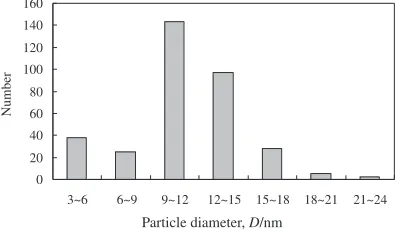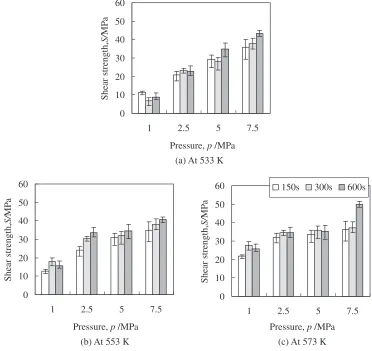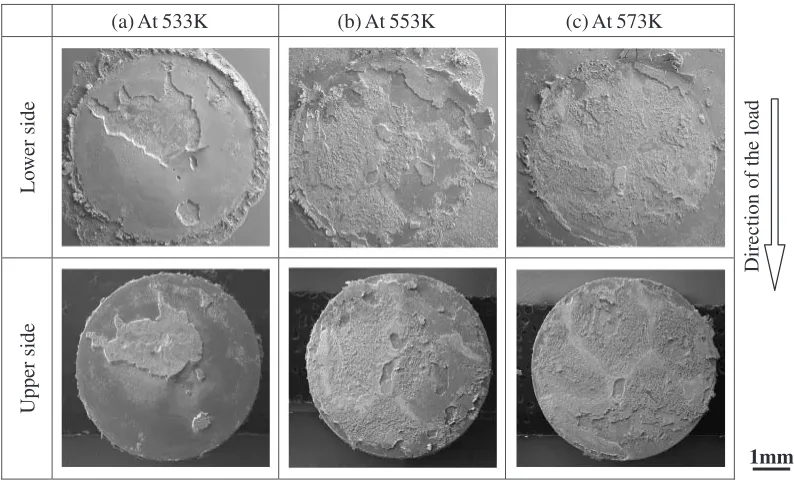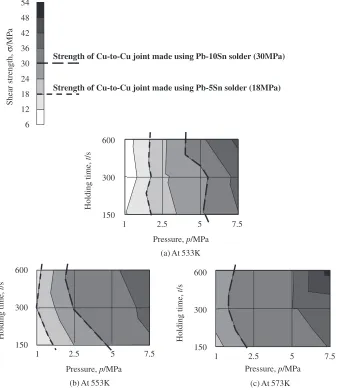Influence of Bonding Condition on Bonding Process Using Ag Metallo-Organic
Nanoparticles for High Temperature Lead-Free Packaging
Eiichi Ide
*, Akio Hirose and Kojiro F. Kobayashi
Department of Manufacturing Science, Graduate School of Engineering, Osaka University, Suita 565-0871, Japan
We have proposed a novel bonding process using Ag metallo-organic nanoparticles with the average particle size of 11 nm, which can be the alternative to the current die-attach process using lead-rich high temperature solders. The metallurgical bonding between Ag and Cu can be achieved in Cu-to-Cu joints using the Ag metallo-organic nanoparticles at temperatures lower than 573 K. Bonding parameters of the Cu-to-Cu joints bondability were examined based on the measurement of the shear strength of the joints and the observation of the fracture surfaces and the cross-sectional microstructures. The joints using the Ag metallo-organic nanoparticles had the joint strength from 10 to 50 MPa depending on bonding conditions. From the results, the bonding conditions providing the joint strength equivalent to those using the lead-rich high melting point solders were proposed.
(Received May 19, 2005; Accepted November 15, 2005; Published January 15, 2006)
Keywords: silver metallo-organic nanoparticles, high temperature solder, lead-free, shear strength
1. Introduction
Recently, lead-free solders have been studied because of the harmfulness of lead. However, numerous studies1)on the
lead-free solders have been focused on the low to middle melting point solders that are the alternatives to the Sn–Pb eutectic solder. On the other hand, an alternative lead-free solder to lead-rich solders used for the die attach in power devices is difficult to be developed. The difficulty arises from the following two requirements on the thermal character-istics: it must have the equivalent bonding temperature to that of current lead-rich solders and it must have the higher solidus temperature than the reflow temperature for the low to middle melting point lead-free solders, such as Sn–Ag system solders. The available alloys satisfying both thermal charac-teristics mentioned above and adequate mechanical proper-ties have not been found, though Shimizu et al.2) have
proposed Zn–4Al–3Mg–3.2Ga and John et al.3) have
pro-posed Ge-Doped Bi–11Ag alloy. For such circumstances, we have proposed a novel bonding process using Ag metallo-organic nanoparticles as the alternative lead-free process to the die attach using the lead-rich solder.4)
However, there is a problem in the use of the nanoparticles. That is ‘‘self-cohesion’’ of the nanoparticles.5) It is the problem that each particle gathers by itself, because the surface of the nanoparticle is very active. Therefore, it is necessary to form protective layer on the surface of nano-particle for the purpose of handling such nanonano-particles. Recently, numerous Ag metallo-organic nanoparticles have been developed. The organic shell contained in the Ag metallo-organic nanoparticles has a function as the passiva-tion layer that prevents the self-cohesion of the nanoparticles. There are mainly two ways to fabricate such Ag metallo-organic nanoparticles. One is physical vapor preparation.6)
The other is chemically reduction method.7)In this research, we used the Ag metallo organic nanoparticles fabricated by the chemically reduction method, and the nanoparticles have the thermal characteristic described bellow. As mentioned
above, the nanoparticles are covered with the organic shell because of the ‘‘self-cohesion’’ problem, yet we needed to lead out the ‘‘self-cohesion’’, in other words, ‘‘active property’’, when applying them to the bonding process. The decomposition temperature of the organic shell to lead out the activate properties is lower than the melting points of the other lead free solders. Consequently, the bonding by the nanoparticles is available at 573 K, which is lower enough to be applied as the alternative to the current lead rich solder. Moreover, the Cu-to-Cu joints by the nanoparticles have significantly higher strengths than the joints using the Ag fine particles. The average size of the Ag fine particle is approximately 100 nm, which is almost 10 times as large as the Ag nanoparticle. In the case of the bonding process by the nanoparticles, the Cu substrate and the sintered Ag layer (which is the Ag layer that derives from the agglomerated Ag nanoparticles after the organic shell was removed by heating) are metallurgically bonded, so that the joint is much more substantial, compared to that by Ag fine particles.8) In the
electronic field, although research regarding the improve-ment of the thermal conductivity of conductive adhesives by using the Ag nanoparticle as the filler particles9)have been reported, there is no research regarding metallurgically bonding using the Ag nanoparticles. Therefore, this is a novel application of nanoparticles. In addition, the sintered Ag layer after bonding is thermally and physically stable because the sintered Ag layer is equivalent to Ag bulk. From this standpoint, this process can be not only the alternative to the lead-rich solder but also a new electronics assembly process. In this paper, the influences of the bonding parameters on the bondability of the Cu-to-Cu joints using the Ag metallo-organic nanoparticles were examined based on the measurement of the shear strength of the joints, the observation of the fracture surfaces and the cross-sectional microstructures. From the results, the bonding conditions providing the joint strength equivalent to those using the lead-rich high melting point solders were proposed.
2. Experimental Procedure
The Ag nanoparticles used in this research are the Ag metallo-organic nanoparticles (hereafter described as Ag nanoparticles) synthesized chemically. The organic shell, which is derived from Myristyl alcohol, has a function as the passivation layer that prevents self-cohesion of the nano-particles. The image of nanoparticles obtained with a transmission electron microscopy (TEM) is shown in Fig. 1. Figure 2 shows the distribution of the particle. The average size of the Ag nanoparticles is around 11 nm, and the particles are isolated from each other. The Ag nanoparticle paste was prepared by mixing the nanoparticles with an organic solvent. The Pb–5Sn and Pb–10Sn solder foils (diameter: 5 mm, thickness: 50mm) were used as reference materials. The shape of the oxygen-free Cu specimens10)used for the bonding experiment is shown in Fig. 3. The faying surfaces of the specimens were polished with 1mmdiamond paste, soaked in dilute hydrochloric acid for 60 s, and then cleaned with distilled water and acetone before bonding. The Ag nanoparticle paste was supplied on the faying surface of the10 mm Cu specimen, which was set on the5 mm Cu specimen. Subsequently, the prepared Cu-to-Cu disc joint specimens with the Ag nanoparticle paste were bonded with varying bonding temperatures (533, 553 or 573 K), holding times (150, 300 or 600 s) and bonding pressures (1, 2.5, 5 or 7.5 MPa) in an infrared oven. The bonding was carried out in air. The reflow condition for the lead-rich solders is 593 K (Pb–5Sn) or 573 K (Pb–10Sn) for 160 s with preheating at 423 K for 60 s (with a rosin type flux). The strength of the Cu-to-Cu joints was measured with a shear cross head speed of
8:3310 5m/s as shown in Fig. 4. For the observation of
the cross-sectional microstructures, the Cu-to-Cu joints were metallographically polished and examined with a scanning electron microscope (SEM) equipped with an electron probe micro analyzer (EPMA). The fracture surfaces of the Cu-to-Cu joints using the Ag nanoparticles were observed with SEM, and the elements of each position of the fracture surfaces were examined with an Energy Dispersion X-ray (EDX) analysis.
3. Results and Discussion
3.1 Influence of bonding parameters on shear strength of Cu-to-Cu joints
During the bonding process using the Ag metallo-organic nanoparticles, both the sintering of the Ag nanoparticles and the bonding of the Ag nanoparticles to the Cu substrate are performed at the same time. The removal of the organic shell from the Ag nanoparticles led out the activated property of the nanoparticles. It is considered that the increase in the bonding temperature and the holding time urges the removal of the organic shell, and the increase in the bonding pressure contributes to the outgassing of the organic shell. Moreover, these bonding parameters affect the sintering and the bonding phenomena of the Ag nanoparticles after the decomposition of the organic shell. In order to investigate the influence of the bonding parameters on these processes, the Cu-to-Cu joints were made with various bonding temperatures, holding times and bonding pressures. Figure 5 shows the shear strength of the Cu-to-Cu disc joints at each bonding temper-ature with various holding times and bonding pressures.
The joint strength increased only a little with the accu-mulation of the holding time in this bonding condition, so the increase in the holding time might promote the sintering of the Ag particles. According to the result, the sintering of the Ag nanoparticles is almost completed by holding for 150 s. On the other hand, the influence of the bonding temper-ature depended on bonding pressure. Under a lower bonding pressure of 2.5 MPa or less, the increase of the bonding
tem-Core metal (Ag nanoparticle)
20nm
Fig. 1 TEM image of Ag metallo-organic nanoparticles.
Number
0 20 40 60 80 100 120 140 160
3~6 6~9 9~12 12~15 15~18 18~21 21~24
Particle diameter, D/nm
Fig. 2 Distribution of particle size.
Diameter : 5 mm
Thickness : 2 mm
Cu disc
Diameter : 10 mm
Thickness : 5 mm
Cu disc
Fig. 3 Shape of specimen.
Bonded joint
Crosshead speed : 8.33 × 10 -5 m/sec
Holding jig
[image:2.595.68.262.73.203.2] [image:2.595.318.531.74.300.2] [image:2.595.70.269.247.363.2]perature considerably raised the joint strength, while under a higher bonding pressure of 5 MPa or more, the joint strength was scarcely affected by the bonding temperature. Finally, the increase in the bonding pressure brought a significant im-provement of the joint strength at each bonding temperature. This is probably because the enhancement of the bonding pressure makes the sintered Ag layer denser and improved the interfacial bonding strength between Ag and Cu.
3.2 Influence of bonding parameters on microstructure and fracture morphology of Cu-to-Cu joints
In order to examine the relationship between the shear strength and the microstructure of the Cu-to-Cu joints, their
cross-sectional microstructures and fracture surfaces were observed. Reflecting the results in the previous section, the difference in the microstructure and fracture morphology depending on the holding time was not recognized so much. A significant influence of the bonding pressure on the microstructure of the joints was recognized as shown in Figs. 6 and 7. Under the low pressure conditions as shown in Fig. 6, a number of submicron voids were observed in the sintered Ag layer at each bonding temperature. However, under the high pressure conditions as shown in Fig. 7, the voids were reduced or disappeared, and the sintered Ag layer became denser. Moreover, the change in the fracture mode was recognized as shown in Figs. 8 and 9. The fracture site (a) At 533 K
(b) At 553 K (c) At 573 K
0 10 20 30 40 50 60
1 2.5 5 7.5
Pressure, p /MPa
Shear strength,
S/
MP
a
150s 300s 600s
0 10 20 30 40 50 60
1 2.5 5 7.5
Pressure, p /MPa
Shear strength,
S/
MP
a
0 10 20 30 40 50 60
1 2.5 5 7.5
Pressure, p /MPa
Shear strength,
S/
MP
a
Fig. 5 The shear strength of Cu-to-Cu disc joint made using Ag metallo-organic nanoparticles at each bonding temperature with various holding time and bonding pressures.
(a) At 533 K (b) At 553 K (c) At 573 K
Sintered Ag layer
Cu
Void
5µm
Sintered Ag layer
Cu
Sintered Ag layer
Cu
[image:3.595.111.483.76.427.2] [image:3.595.96.497.479.589.2](a) At 533 K (b) At 553 K (c) At 573 K Sintered Ag layer
Cu
5µm
Sintered Ag layer
Cu
Sintered Ag layer
Cu
Fig. 7 BE images of Cu/Ag interface in the joints bonded at various bonding temperature for 300 s under bonding pressure of 5 MPa.
(a) At 533 K (b) At 553 K (c) At 573 K
Lo
wer side
Upper side
1mm
Direction of the load
Region B
Region A
Region B
Region A
Fig. 8 SE images of fracture surfaces of Cu-to-Cu joints bonded at various bonding temperature for 300 s under bonding pressure of 1 MPa.
(a) At 533K (b) At 553K (c) At 573K
Lo
wer side
Upper side
1mm
Direction of the load
[image:4.595.95.498.74.185.2] [image:4.595.98.498.227.469.2] [image:4.595.99.496.517.758.2]was migrated from the Ag/Cu interfacial to the sintered Ag layer. These results show that both the strength of the Ag layer and the interface between Ag/Cu were enhanced, and the Ag/Cu interfacial strength was more than that of the sintered Ag layer under the high pressure conditions.
The influence of the bonding temperature was not
recognized from the microstructure observation of the sintered Ag layer. However, the fracture morphology was affected by the bonding temperature under a pressure of 1 MPa. Figure 10 shows the higher magnification images of the region A in Fig. 8(b) and the EDX spectra of the points A and B respectively. Figure 11 shows the higher magnification 10µµm 10µm
Point A Point B
(a) Sintered Ag side (Lower side) (b) Cu side (Upper side)
(c) Point A (d) Point B 0
500 1000 1500 2000 2500
0 250 500 750 1000 Energy, E /keV
Counts
0 500 1000 1500 2000 2500
0 250 500 750 1000 Energy, E /keV
Counts
Ag
Cu Cu
[image:5.595.143.456.73.355.2]Cu Ag
Fig. 10 SE images of region A in Fig. 8(b) and EDX spectra of points A and B.
0 500 1000 1500 2000 2500
0 250 500 750 1000 Energy, E /keV
Counts
0 500 1000 1500 2000 2500
0 250 500 750 1000 Energy, E /keV
Counts
(a) Sintered Ag side (Lower side) (b) Cu side (Upper side)
Point C Point D
Ag
Cu Cu
Cu Cu
Cu O
(c) Point C (d) Point D
10µm 10µm
[image:5.595.147.453.389.672.2]images of the region B in Fig. 8(b) and the EDX spectra of the points C and D respectively. In the region A, Ag was detected on the Cu side and the fractured Ag layer was elongated and deformed. Therefore, the fracture was propa-gated within the sintered Ag layer around the Ag/Cu interface. However, Ag was not detected on the Cu side and the plastic deformation was not recognized on the fractured surface in the region B (Fig. 11). It is considered that the Ag/Cu interfacial strength in this region was not sufficient. In addition, the Cu detected on the sintered Ag side [Fig. 11(c)] might be caused by the Cu oxide. This suggests that the Cu oxide film remained and the metallurgical bonding of Ag to Cu couldn’t be achieved in this region. The area of the region A declined in the fracture surface of the joint bonded at a lower temperature of 533 K as shown in Fig. 8(a). On the contrary, it expanded in the joint bonded at a higher temperature of 573 K as shown in Fig. 8(c). These results suggest that the Ag/Cu interfacial strength was enhanced by the increase of the bonding temperature, and this effect was more significant under the low bonding pressure conditions. The increase in a bonding temperature more effectively shortens the period of the decomposition of the
organic shell than that of the holding time does. It is expected that this effect improves the bondability to Cu.
3.3 The comparisons with the lead-rich solder joints
Figure 12 shows the contour maps for the shear strength that were constructed from the results of Fig. 5. Two kinds of the dotted line in Fig. 12 show the strength of the Cu-to-Cu joints using the Pb–5Sn solder and the Pb–10Sn solder respectively. The joints using the Ag metallo-organic nano-particles had higher strength than those using the current lead-rich solders under wide bonding conditions. The bond-ing conditions that satisfy the lower basis of the joint strength for alternative to the Pb–5Sn solder, 18 MPa, are quite wide range including a low bonding temperature and a low bonding pressure. The rise of the bonding temperature and the increase in the bonding pressure can meet the higher basis of the joint strength for the alternative to the Pb–10Sn solder, 30 MPa.
4. Conclusion
We have proposed a novel bonding process using Ag
Shear strength,
σ
/MP
a
Strength of Cu-to-Cu joint made using Pb-10Sn solder (30MPa)
Strength of Cu-to-Cu joint made using Pb-5Sn solder (18MPa)
1 2.5 5 7.5
150 300 600
Pressure, p/MPa
Holding time,
t
/s
1 5
150 300 600
Pressure, p/MPa
Holding time,
t
/s
1 2.5 5
150 300 600
Pressure, p/MPa
Holding time,
t
/s
54
48
42
36
30
24
18
12
6
(a) At 533K
(b) At 553K (c) At 573K
2.5 7.5 7.5
metallo-organic nanoparticles, which can be alternative to that using lead-rich high melting point solders. The following results were obtained in this study:
(1) The joint strength increased only a little with increasing holding time in this bonding condition, though the accumulation in the holding time may promote the sintering of the Ag particles. This suggests that the sintering of the Ag is almost completed after hold time of 2.5 min.
(2) The increase in the bonding pressure brought the significant improvement of the joint strength at each bonding conditions. In particular, this improvement is more prominent at lower bonding temperature. (3) The increase in the bonding temperature considerably
raised the joint strength under a lower bonding pressure of 2.5 MPa or less, while the joint strength was little affected by a bonding temperature under a higher bonding pressure of 5 MPa or more.
(4) The bonding conditions that meet the basis of the joint strength for the alternative to the conventional lead-rich solders were presented.
Acknowledgement
This research was partly supported by ‘Priority Assistance
of the Formation of Worldwide Renowned Centers of Research—The 21st Century COE Program (Project: Center of Excellence for Advanced Structural and Functional Materials Design)’ and a Grant-in-Aid for Scientific Research Development from the Ministry of Education, Culture, Sports, Science and Technology of Japan.
REFERENCES
1) A. Hirose, H. Yanagawa, E. Ide and K. F. Kobayashi: Sci. Technol. Adv. Mater.5(2004) 267.
2) T. Shimizu, H. Ishikawa, I. Ohnuma and K. Ishida: J. Electro. Mater.28 (1999) 1172.
3) J. N. Lalena, N. F. Dean and M. W. Weiser: J. Electro. Mater.31(2002) 1244.
4) E. Ide, S. Angata, A. Hirose and K. F. Kobayashi:Proc. of the 13th Sympo. on Microelectro.(2003) p. 96.
5) Lopes WA: Phys. Rev. E65(2001) 031606. 6) M. Oda: J. Jpn. Inst. Electro. Packag.5(2002) 523.
7) H. Nagasawa, M. Maruyama, T. Komatsu, S. Isoda and T. Kobayashi: Phys. Status Solidi67(2002) 191.
8) E. Ide, S. Angata, A. Hirose and K. F. Kobayashi: Acta Mater.53 (2005) 2385.
9) Y. Ukita, K. Tateyama, M. Segawa, Y. Tojo, H. Gotoh and K. Oosako: in 38th Int. Microelectro. and Pakag. Sympo., (2004) WA7. 10) Test methods for lead-free solders—Part 5: methods for tensile tests




